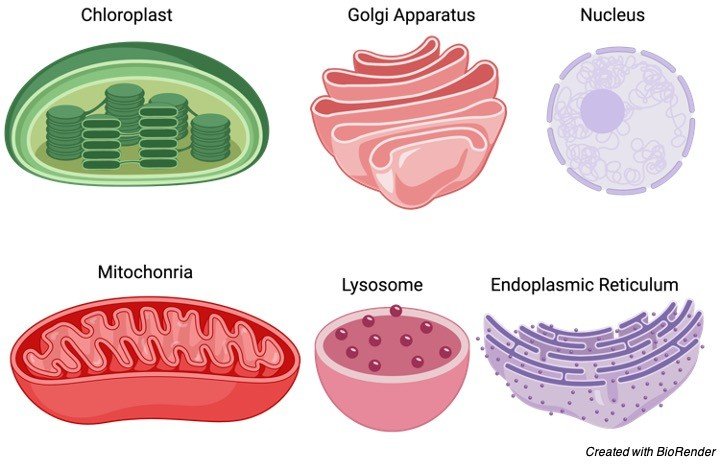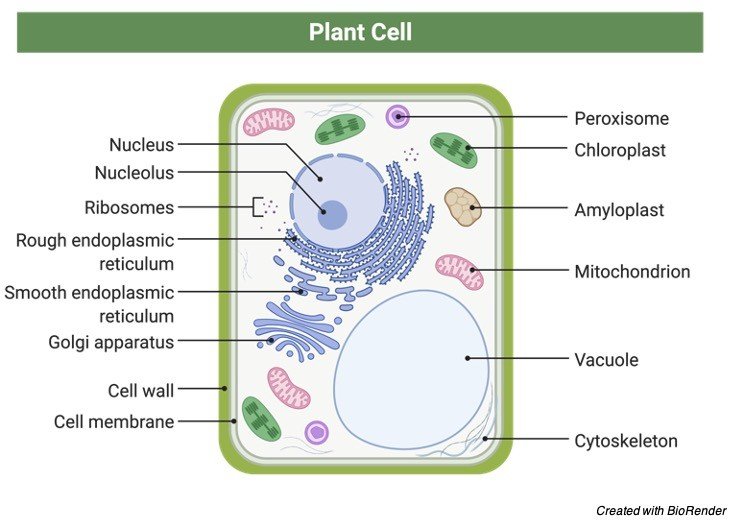What Organelle Is Specific To Animal Cells
Table of Contents
What is Cell Organelle?
Cell Organelle Definition
Cell Organelle Etymology
Cell Organelle vs Inclusions
The living components inside the cell are known every bit organelles. Cell inclusions, on the other hand, are non-living elements found inside the prison cell. The term "not-living" refers to the fact that the inclusions do not perform the biological functions that organelles do. Fatty droplets, glycogen, and pigment granules, such every bit melanin, lipofuscin, and hemosiderin, are all included.
Eukaryotic vs Prokaryotic Organelle
The nucleus, endoplasmic reticulum, Golgi appliance, mitochondria, and chloroplast are just a few of the organelles establish in eukaryotic cells (plastids). Non all of these organelles, even so, are located in a single jail cell or organism.
Plant cells, for example, have a lot of chloroplasts, while animal cells don't. According to the endosymbiotic hypothesis, there are organelles that accept their own DNA separate from the nucleus and are thought to have arisen from endosymbiotic leaner. Mitochondria and plastids are the organelles in question.
Prokaryotes, which were previously thought to lack organelles, have lately been shown to have their own type of "organelle." However, they are sometimes referred to equally proteinaceous micro-compartments rather than genuine organelles in other sources. The Carboxysome (a poly peptide-shell compartment in some bacteria for carbon fixation), chlorosome (a calorie-free collecting complex in greenish sulphur bacteria), magnetosome (found in magnetotactic bacteria), and thylakoid are examples (in some cyanobacteria).
Types of Cell Organelle
Animal Cell Diagram
Other sources, on the other hand, are less restricted. An organelle is a specialised component of a cell that has a divers purpose. Organelles may exist divided into two categories: membrane-leap organelles (which include both double-membraned and single-membraned cytoplasmic structures) and non-membrane-bound organelles (also referred to as biomolecular complexes or proteinaceous organelles).
Plant Cell Diagram
I. Membrane Bound Organelle
i. Nucleus
ii. Endoplasmic Reticulum
iii. Golgi Apparatus
four. Mitochondria
v. Plastids
Plant cells contain plastids, which are double-membrane-bound organelles found in photosynthetic cells. Chloroplasts, chromoplasts, and leucoplasts are the 3 kinds of plastids. Chloroplasts are photosynthesis-related plastids that contain greenish pigment. Chromoplasts are plastids that include colours other than green. Leucoplasts are pigment-gratis plastids that take a office in food storage.
vi. Lysosomes
7. Vacuoles
viii. Endosomes
II. non-Membrane Bound Organelle
Cell Organelle Function
Each of the organelles has a particular part.
Nucleus: Information technology is responsible for preserving Deoxyribonucleic acid integrity and managing cellular functions such every bit metabolism, growth, and reproduction.
Mitochondrion: Through the process of cellular respiration, information technology is responsible for producing the majority of the cell'southward adenosine triphosphate supply.
Plastids: Food storage and photosynthesis are two functions of this organ.
Endoplasmic Reticulum: Poly peptide and lipid synthesis, glucose metabolism, calcium concentration, drug detoxification, receptor attachment to cell membrane proteins, and intracellular send are all involved.
Golgi Apparatus: Glycosylation, packaging of molecules for secretion, lipid ship throughout the cell, and the germination of lysosomes are all functions of this protein.
Lysosomes: In particular, for digestion and the emptying of extra or worn-out organelles, nutrient particles, and ingested viruses or germs.
Vacuole: Structure support, intracellular secretion, excretion, storage, and digesting are all functions of this protein.
Ribosome: Protein synthesis takes place here.
Nucleosome: The chromatin's fundamental structural unit.
Centriole: Involved in the nuclear division process.
Cytoskeleton: It controls cell shape, maintains intracellular structure, and regulates jail cell mobility.
Cell Organelle Pathology
Nuclear genetic material is stored in the nucleus. Mutations in genes or chromosomes can have negative consequences or cause genetic diseases. Mutations in the mitochondria and chloroplasts' extranuclear genetic fabric might also cause unhealthy or dysfunctional situations.
Lysosomal storage disease is a metabolic disorder caused by a malfunction in lysosomal role that results in an abnormal buildup of harmful chemicals in the cell. Lysosomal storage disorders are passed down through generations. The malfunctioning lysosomal enzyme is acquired by a mutation in a specific faulty gene.
The nucleus is where genetic material is stored. Cistron or chromosomal mutations can have severe repercussions or pb to genetic disorders. Mutations in the extranuclear genetic material of mitochondria and chloroplasts may potentially result in harmful or dysfunctional weather condition.
A failure in lysosomal function causes an abnormal aggregating of toxic substances in the prison cell, resulting in lysosomal storage disease. Storage abnormalities of the lysosome are handed down through the generations. A mutation in a specific defective factor causes the lysosomal enzyme to fail.
Cell Organelle Citations
- Formation of plant cell wall supramolecular structure. Biochemistry (Mosc) . 2010 Feb;75(2):159-72.
- Establish jail cell wall-mediated immunity: cell wall changes trigger affliction resistance responses. Institute J . 2018 Feb;93(iv):614-636.
- How Bacteria Subvert Animal Cell Structure and Role. Annu Rev Cell Dev Biol . 2016 Oct half-dozen;32:373-397.
- Shedding light on the jail cell biology of extracellular vesicles. Nat Rev Mol Prison cell Biol . 2018 Apr;xix(4):213-228.
Like Post:
Source: https://researchtweet.com/cell-organelle-definition-types-function/
Posted by: odommrsoled.blogspot.com





0 Response to "What Organelle Is Specific To Animal Cells"
Post a Comment